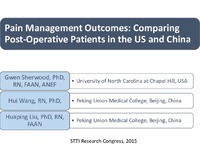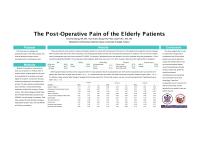| dc.contributor.author | Sherwood, Gwen D. | en |
| dc.contributor.author | Wang, Hui | en |
| dc.contributor.author | Liu, Huaping | en |
| dc.date.accessioned | 2016-03-17T12:58:20Z | en |
| dc.date.available | 2016-03-17T12:58:20Z | en |
| dc.date.issued | 2016-03-17 | |
| dc.identifier | INRC15B15 | |
| dc.identifier.uri | http://hdl.handle.net/10755/601892 | |
| dc.description | <p>Research Congress 2015 Theme: Question Locally, Engage Regionally, Apply Globally. Held at the Puerto Rico Convention Center.</p> | en |
| dc.description.abstract | <p>Session presented on Friday, July 24, 2015:</p>
<p><strong>Purpose:</strong> Postoperative pain management has posed a pervasive clinical problem in medical practice. Improving quality of pain management has been a focus for more than 20 years in America, but it hasn't become one of the routine tasks for professionals in China. Evidence of ethnic differences in pain perception and analgesia consumption may influence patient outcomes in pain management. Differences in patient outcomes of pain management between Chinese and American patients continues to be a persistent question. The purpose of this study is to investigate differences in patient outcomes and methods of pain management in post-operative patients between a Chinese and an American large teaching hospital.</p>
<p><strong>Methods:</strong> A descriptive comparative survey assessed outcomes of pain management using the Revised American Pain Society Pain Outcome Questionnaire (APS-POQ-R), including pain severity and interference in sleep, activity and mood, adverse effects and perception of care. Current pain, average pain and pain management goal were also measured. Demographic information included type of surgery and analgesics ordered and administered were collected from the medical record. A convenience sample of 244 adult inpatients on the first postoperative day were recruited from a 803-bed hospital in North Carolina, United States. Subsequently, 286 patients with similar surgeries were recruited from a 1860-bed hospital in Beijing, China. To assure comparable data , the final sample included 231 patients in US and 248 patients in China who had intermediate and major post operative pain.</p>
<p><strong>Results:</strong> Demographic and surgical characteristics of patients were comparable: aged 51.13+/-15.572 (range from18 to 84) years old in US and 51.98+/-14.979 (range from18 to 84) in China. 61.8% (N=143) of the patients in US and 56.5% (N=140) in China were female, and 45(19.5%) and 65 (26.2%) patients were diagnosed as cancer respectively. Surgery type was similar in two countries: the majority was non-endoscopic (N=179, 77.4% US vs N=188, 75.8% China) and located in abdomen/pelvic (N=109, 47.2% US vs N=117, 47.2% China). Most of the patients in US used PCA (N=138, 59.7%) and non-PCA (N=92, 39.8%) treatments, while about half patients in China didn't use any medicine at all (n=128, 51.6%) and 33.1% (N=82) patients used PCA. 31.6% (N=12) of the patients using non-PCA treatments used meperidine intramuscular route for pain in China while none in US. In subgroup using PCA, patients in US consumed a little higher parenteral morphine equianalgesic dose (0.55mg) per kg weight than that in China (0.43mg). Out of expectation, patients in US had experienced higher level of pain, interference of pain and side effect of treatments, but with better perception of pain care (8.02 vs 6.36). But the amounts of differences were very limited. Difference in mean of the least (3.45 vs 2.68) and worst (8.00 vs 6.04) pain level were less than 30%, which was considered minimum clinical meaning, while difference in mean of the present pain (4.33 vs 2.57), average pain (5.93 vs 3.68), affective interference (3.23 vs 1.51) and side effects of pain treatment (3.44 vs 1.85) were higher than 30%. The pain management goal in US patients was a little higher than that in China (3.14 vs 2.30). Compared with the goal level of pain management, only the least pain level is clinically comparable in both countries.</p>
<p><strong>Conclusions:</strong> Patients in US were experiencing a slightly higher pain level on average and more interference with activities than that in China. Patients in US had used more pain medicine and suffered more adverse effects than those in China. Difference in perception of pain may be the best explanation. Patients reported differences between the actual pain and the goal of pain management in both countries. With increasing population diversity, continuing research is needed to better understand differences in pain management outcomes between the two populations, and to better understand how patients respond to pain, utilize analgesics, and manage pain expectations during the post-operative period.</p> | en |
| dc.format | Text-based Document | en |
| dc.language.iso | en | en |
| dc.subject | Pain Management Outcomes | en |
| dc.subject | Cultural Care | en |
| dc.subject | Chinese Patients | en |
| dc.title | Pain management outcomes: Comparing post-operative patients in the U.S. and China | en |
| dc.title.alternative | International Research to Improve Patient Care | en |
| dc.type | Presentation | en |
| dc.rights.holder | <p>
All rights reserved by the author(s) and/or publisher(s) listed in this item record unless relinquished in whole or part by a rights notation or a Creative Commons License present in this item record.
</p><p>
All permission requests should be directed accordingly and not to the Sigma Repository.
</p><p>
All submitting authors or publishers have affirmed that when using material in their work where they do not own copyright, they have obtained permission of the copyright holder prior to submission and the rights holder has been acknowledged as necessary.
</p> | |
| dc.description.note | <p>Items submitted to a conference/event were evaluated/peer-reviewed at the time of abstract submission to the event. No other peer-review was provided prior to submission to the Henderson Repository.</p> | |
| dc.type.category | Full-text | en |
| dc.evidence.level | N/A | en |
| dc.research.approach | N/A | en |
| dc.contributor.department | Alpha Alpha | en |
| dc.author.details | Gwen Sherwood, RN, FAAN; Hui Wang, RN; Huaping Liu, RN, FAAN | en |
| dc.conference.name | 26th international Nursing Research Congress | en |
| dc.conference.host | Sigma Theta Tau international | en |
| dc.conference.location | San Juan, Puerto Rico | en |
| dc.date.conferenceyear | 2015 | |
| dc.contributor.affiliation | The University of North Carolina at Chapel Hill, Chapel Hill, North Carolina, USA | en |
| dc.description.reviewtype | Abstract Review Only: Reviewed by Event Host | en |
| dc.description.acquisition | Proxy-submission | en |





